abbydaddy
Gold Member
- Joined
- Oct 14, 2014
- Messages
- 3,227
Here is my review of the CPK LC. As per usual, you can find this review on my blog here, but the review is the same here.

Carothers Performance Knives Light Chopper in Delta 3V with TeroTuf handle scales
Introduction:
This review is a special one for me, but also a little sad because the pattern is being retired. I have been looking forward to reviewing the Light Chopper (LC) since I started following following the design process for this knife back in 2015. This knife became a dream knife for me, but it wasn't until a month and a half ago that I finally got my hands on one. Then I found out that Carothers Performance Knives (CPK) is discontinuing this pattern. There will be a similar pattern called the Medium Chopper that will be released, and I may review one for contrast, but I think it is a real shame that this pattern is being discontinued. CPK knives are tricky to get hold of already, but I had hoped that after more Light Choppers were produced it would get easier, sadly it looks like less than 500 or so will be produced in total.
One day a week I clear brush. During my undergraduate years I supported myself with landscaping and brush clearing, and I still enjoy it enough to keep clearing brush part time while I work on grad school. So I was very excited about this tool being developed because it is designed to be a chopper that can swing fast enough to handle springy materials while still being easier to carry than something like a machete without being too heavy. I don't like carrying a machete when I am walking and operating a weed-whacker or other tools all day, but the Difensa proved the value of having a fixed blade that can handle some chopping. The Light Chopper manages to combine the cutting and chopping power of a machete with a size that is just about the maximum size and weight that I find comfortable to carry on my hip. For me the LC manages a darn near magical Goldilocks ratio of chopping capability and carry-ability. The LC isn't great for a lot of other uses, but it is fantastic in its intended applications.
The knife is made by Carothers Performance Knives, which is headed by Nathan Carothers (and his wife Jo). Nathan Carothers is a very experienced machinist, with a vast materials knowledge, as well as a truly impressive capability at using CNC machining. He is also very willing to share his knowledge, I have learned a lot over the last year and a half or so paying attention to Carothers (Here is a BladeForums thread of people asking Nathan questions and him answering, it is educational and about 50 pages long). CPK is an exciting brand to pay attention to, but at the current time demand is far exceeding their production capability which makes it hard to get a lot of CPK knives. Sales for the Light Chopper (for example) are typically for 20 or so at a time, and they usually sell out in less than 5 seconds. The other option is to buy the knives on the secondary market (which is how I purchased the reviewed knife), but prices can vary dramatically, and availability is still limited.
The knife was designed in cooperation with Lorien Arnold, a talented knife designer from British Columbia, Canada. Lorien cooperates with numerous knife makers, but has been partnering extensively with CPK recently. Sadly I can't afford the custom knives he designs, but I am a fan nonetheless.
The TL;DR review summary:
I love this knife. For clearing brush and light undergrowth, with a knife that isn't too big or heavy to carry on a hike, this knife is ideal. The outstanding materials and exceptional treatment of those materials makes this knife a truly impressive performer. The design and craftsmanship that goes into this knife make it well worth the trouble it takes to land one.
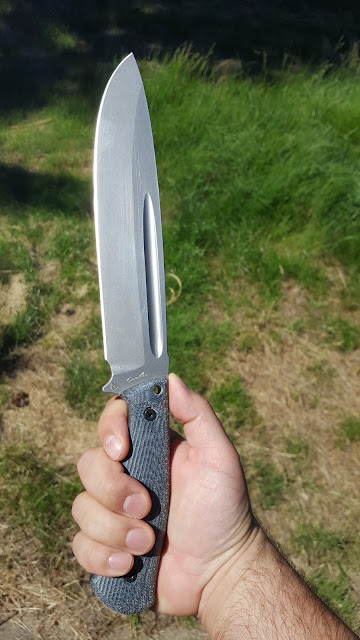
This knife is big enough that it doesn't even look small in my hands! I don't usually post pictures of the knives I review in my hands because my extra-large hands (size 10 1/2-11) don't provide a useful sense of scale for most people. But trust me, this is a substantial knife.
Let's Start With the Specs:
(From Carothers Performance Knives website):
Steel: CPM 3V (With the proprietary heat treat applied to Carothers 3V this metal is known as Delta3V)
Hardness: 60.5 HRC
Thickness: .188” thick at ricasso
Total length: 15.625”
Blade length: 9.875”
Edge is sharpened 20 DPS
Weight: 17.1 oz
Handle: Grippy 3D machined scales in micarta or TeroTuf (The reviewed knife has TeroTuff handle scales)
Black oxide treated 18-8 stainless steel fasteners
The Light Chopper is only "light" for a chopper. The knife weighs more than a pound. But while 17.1 oz might seem like a lot, a Gerber Gator Machete (the machete I primarily used for significant chopping prior to the LC) is 18 oz while being almost a foot longer. So the LC is actually lighter than most regular sized machetes in a much smaller package, and if you compare the LC to fancier machetes like the Baryonyx Machete then the weigh and size savings become even more pronounced.
The handle of the LC is made out of TeroTuf. TeroTuf is a composite material somewhat similar to G10 or Micarta. All three materials are made out of layered textiles compressed with resin. The difference in TeroTuf is that both the textile and the resin are polyester, as opposed to phenolic resins with either fiberglass (G10) or a variety of materials (paper, linen, canvas) for micarta. There are a few advantages to TeroTuf: For the knife maker, TeroTuf produces less toxic gases during machining. But from a user's perspective the biggest advantage would be lateral toughness (Here is a good video demonstration by HelmGrind) and enhanced grippyness. Since G10 and Micarta already have outstanding lateral toughness and dimensional stability the only real edge from my perspective is grip. I found the TeroTuf to be a little grippier when dry than unfinished micarta. I prefer canvas micarta for the most knife applications, but I really think the TeroTuf is an excellent choice for a chopper.
In the past I have satisfied myself with the following description of CPM 3V:
The steel for this knife is CPM 3V. CPM 3V is a particle super steel, as I have said before, these steels are made with science magic. I'm not going to try to explain all of the specifics because I am not a metallurgist and blade steel is a surprisingly complicated topic. There is no one perfect steel for every knife. Each steel type has its own set of properties, and the choice of which properties are important to a knife is a key decision for knife makers. Additionally, the properties of various steels are affected by heat treatment (the ways that the metal is heated and cooled to control hardness) and heat treatment can even affect the crystalline structure of the steel and the ways that the compounds in the steel combine. So for the purposes of my reviews, science magic.
That said, I think it is worthwhile to discuss the characteristics of CPM 3V a little. CPM 3V is not a stainless steel, though it does contain 7.5% chromium, which provides more stain resistance than one might expect from a carbon steel. In terms of edge holding properties at the hardness used for this knife, CPM 3V is very comparable to CPM S35VN (which is the stainless particle steel the Difensa is made of). The biggest difference between 3V and S35VN (besides rust resistance) is toughness. 3V is roughly 3 times as impact resistant as S35VN. It is a very tough steel, appropriate for a knife intended for rough applications.
To sum up on the steel: CPM 3V is very, very tough, not stainless, and holds an edge well.
But for the Delta 3V (D3V) I think a little more discussion is needed. This is really an exceptional heat treat of an already outstanding steel. Nathan Carothers (AKA Nathan The Machinist on BladeForums) developed his proprietary heat treat of 3V that provides a pretty unbeatable combination of hardness, toughness, lateral strength, resilience, edge retention, and as an added bonus the heat treat leaves a higher percentage of free chromium in the steel matrix which makes D3V almost-but-not-quite-stainless. Standard 3V is an excellent steel, D3V elevates that steel to a level that is unmatched in my experience for a heavy use knife (Busse knives uses a proprietary steel called INFI which is generally considered the industry standard for heavy use knives, but I have never used an INFI knife myself).

Carothers Performance Knives Light Chopper in Delta 3V with TeroTuf handle scales
Introduction:
This review is a special one for me, but also a little sad because the pattern is being retired. I have been looking forward to reviewing the Light Chopper (LC) since I started following following the design process for this knife back in 2015. This knife became a dream knife for me, but it wasn't until a month and a half ago that I finally got my hands on one. Then I found out that Carothers Performance Knives (CPK) is discontinuing this pattern. There will be a similar pattern called the Medium Chopper that will be released, and I may review one for contrast, but I think it is a real shame that this pattern is being discontinued. CPK knives are tricky to get hold of already, but I had hoped that after more Light Choppers were produced it would get easier, sadly it looks like less than 500 or so will be produced in total.
One day a week I clear brush. During my undergraduate years I supported myself with landscaping and brush clearing, and I still enjoy it enough to keep clearing brush part time while I work on grad school. So I was very excited about this tool being developed because it is designed to be a chopper that can swing fast enough to handle springy materials while still being easier to carry than something like a machete without being too heavy. I don't like carrying a machete when I am walking and operating a weed-whacker or other tools all day, but the Difensa proved the value of having a fixed blade that can handle some chopping. The Light Chopper manages to combine the cutting and chopping power of a machete with a size that is just about the maximum size and weight that I find comfortable to carry on my hip. For me the LC manages a darn near magical Goldilocks ratio of chopping capability and carry-ability. The LC isn't great for a lot of other uses, but it is fantastic in its intended applications.
The knife is made by Carothers Performance Knives, which is headed by Nathan Carothers (and his wife Jo). Nathan Carothers is a very experienced machinist, with a vast materials knowledge, as well as a truly impressive capability at using CNC machining. He is also very willing to share his knowledge, I have learned a lot over the last year and a half or so paying attention to Carothers (Here is a BladeForums thread of people asking Nathan questions and him answering, it is educational and about 50 pages long). CPK is an exciting brand to pay attention to, but at the current time demand is far exceeding their production capability which makes it hard to get a lot of CPK knives. Sales for the Light Chopper (for example) are typically for 20 or so at a time, and they usually sell out in less than 5 seconds. The other option is to buy the knives on the secondary market (which is how I purchased the reviewed knife), but prices can vary dramatically, and availability is still limited.
The knife was designed in cooperation with Lorien Arnold, a talented knife designer from British Columbia, Canada. Lorien cooperates with numerous knife makers, but has been partnering extensively with CPK recently. Sadly I can't afford the custom knives he designs, but I am a fan nonetheless.
The TL;DR review summary:
I love this knife. For clearing brush and light undergrowth, with a knife that isn't too big or heavy to carry on a hike, this knife is ideal. The outstanding materials and exceptional treatment of those materials makes this knife a truly impressive performer. The design and craftsmanship that goes into this knife make it well worth the trouble it takes to land one.

This knife is big enough that it doesn't even look small in my hands! I don't usually post pictures of the knives I review in my hands because my extra-large hands (size 10 1/2-11) don't provide a useful sense of scale for most people. But trust me, this is a substantial knife.
Let's Start With the Specs:
(From Carothers Performance Knives website):
Steel: CPM 3V (With the proprietary heat treat applied to Carothers 3V this metal is known as Delta3V)
Hardness: 60.5 HRC
Thickness: .188” thick at ricasso
Total length: 15.625”
Blade length: 9.875”
Edge is sharpened 20 DPS
Weight: 17.1 oz
Handle: Grippy 3D machined scales in micarta or TeroTuf (The reviewed knife has TeroTuff handle scales)
Black oxide treated 18-8 stainless steel fasteners
The Light Chopper is only "light" for a chopper. The knife weighs more than a pound. But while 17.1 oz might seem like a lot, a Gerber Gator Machete (the machete I primarily used for significant chopping prior to the LC) is 18 oz while being almost a foot longer. So the LC is actually lighter than most regular sized machetes in a much smaller package, and if you compare the LC to fancier machetes like the Baryonyx Machete then the weigh and size savings become even more pronounced.
The handle of the LC is made out of TeroTuf. TeroTuf is a composite material somewhat similar to G10 or Micarta. All three materials are made out of layered textiles compressed with resin. The difference in TeroTuf is that both the textile and the resin are polyester, as opposed to phenolic resins with either fiberglass (G10) or a variety of materials (paper, linen, canvas) for micarta. There are a few advantages to TeroTuf: For the knife maker, TeroTuf produces less toxic gases during machining. But from a user's perspective the biggest advantage would be lateral toughness (Here is a good video demonstration by HelmGrind) and enhanced grippyness. Since G10 and Micarta already have outstanding lateral toughness and dimensional stability the only real edge from my perspective is grip. I found the TeroTuf to be a little grippier when dry than unfinished micarta. I prefer canvas micarta for the most knife applications, but I really think the TeroTuf is an excellent choice for a chopper.
In the past I have satisfied myself with the following description of CPM 3V:
The steel for this knife is CPM 3V. CPM 3V is a particle super steel, as I have said before, these steels are made with science magic. I'm not going to try to explain all of the specifics because I am not a metallurgist and blade steel is a surprisingly complicated topic. There is no one perfect steel for every knife. Each steel type has its own set of properties, and the choice of which properties are important to a knife is a key decision for knife makers. Additionally, the properties of various steels are affected by heat treatment (the ways that the metal is heated and cooled to control hardness) and heat treatment can even affect the crystalline structure of the steel and the ways that the compounds in the steel combine. So for the purposes of my reviews, science magic.
That said, I think it is worthwhile to discuss the characteristics of CPM 3V a little. CPM 3V is not a stainless steel, though it does contain 7.5% chromium, which provides more stain resistance than one might expect from a carbon steel. In terms of edge holding properties at the hardness used for this knife, CPM 3V is very comparable to CPM S35VN (which is the stainless particle steel the Difensa is made of). The biggest difference between 3V and S35VN (besides rust resistance) is toughness. 3V is roughly 3 times as impact resistant as S35VN. It is a very tough steel, appropriate for a knife intended for rough applications.
To sum up on the steel: CPM 3V is very, very tough, not stainless, and holds an edge well.
But for the Delta 3V (D3V) I think a little more discussion is needed. This is really an exceptional heat treat of an already outstanding steel. Nathan Carothers (AKA Nathan The Machinist on BladeForums) developed his proprietary heat treat of 3V that provides a pretty unbeatable combination of hardness, toughness, lateral strength, resilience, edge retention, and as an added bonus the heat treat leaves a higher percentage of free chromium in the steel matrix which makes D3V almost-but-not-quite-stainless. Standard 3V is an excellent steel, D3V elevates that steel to a level that is unmatched in my experience for a heavy use knife (Busse knives uses a proprietary steel called INFI which is generally considered the industry standard for heavy use knives, but I have never used an INFI knife myself).
Last edited:

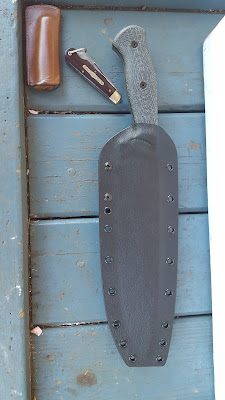
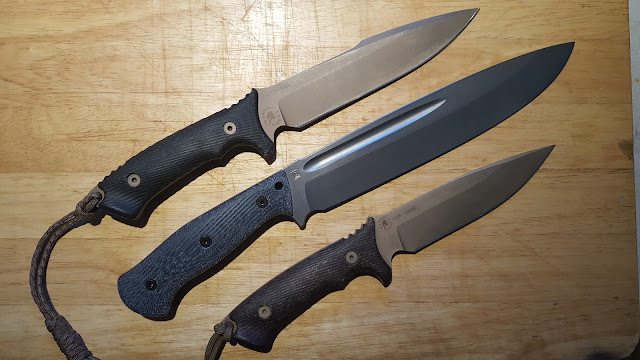


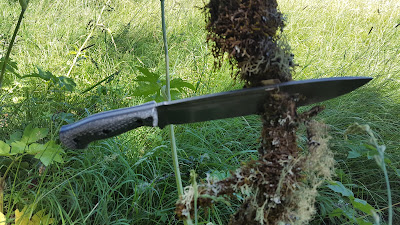
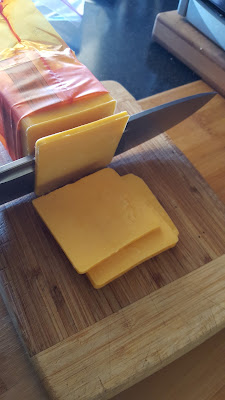

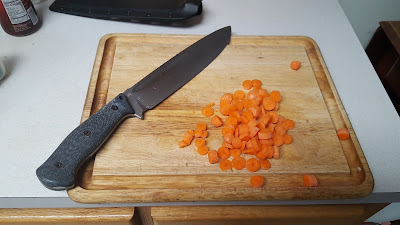
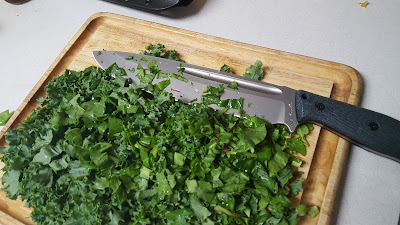
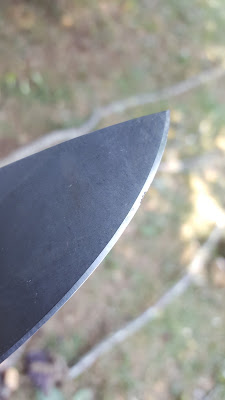

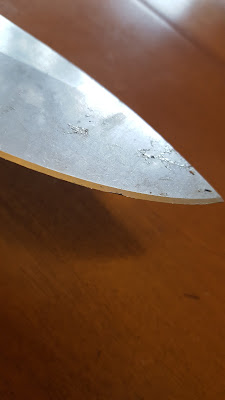
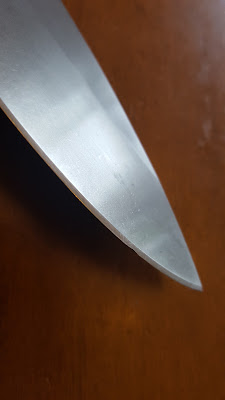
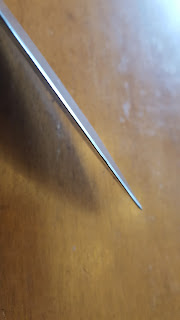
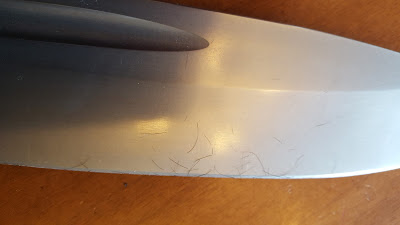
 Great review
Great review